The first "Stalinist strike": the complete elimination of the blockade of Leningrad
The situation before the start of the operation
Despite the brutal defeat suffered in 1943, the German armed forces were still a dangerous adversary. The absence of a second front in Western Europe contributed to the German military and political command, allowing it to concentrate the main forces and means against the Red Army. The fighting, which the Allies led in Italy, in terms of their significance and scope, could not claim to be the second front. Throughout the Eastern Front, the Germans created powerful defensive lines with skillful use of natural conditions. In the course of all the operations of the Red Army in 1944, the German troops proved themselves to be an extremely skilled and stubborn enemy. The Germans showed exceptional stamina, discipline and high professionalism, defending the territories they captured. The Wehrmacht incessantly struck Soviet troops with counterstrikes, trying to push the enemy, to produce local environments. German troops were the most serious opponent of the Russian army for all its history.
However, the Red Army quickly learned and already outdid the enemy both in skill and in the number of personnel and equipment. The Soviet industry surpassed the German one: “Magnitka won the Ruhr”. It was a real battle of the titans. And the USSR won a well-deserved victory in it, breaking the power of the German Empire and its satellites.
The Soviet command in December 1943 decided during the winter campaign to launch an offensive from Leningrad to the Black Sea, with particular attention being paid to the flanks of the Soviet-German front. In the southern direction, liberate the Right-Bank Ukraine and Crimea, exit in the spring to the state border. In the north, defeat Army Group North, completely lift the blockade from Leningrad and go to the borders of the Baltic republics. It was decided to deliver a series of powerful sequential strategic strikes. In order to break through the enemy defenses created powerful force groups. Each group received a pronounced shock character by giving them tanks, artillery and aviation. The main offensive strategic operations of 1944 were called "Ten Stalinist strikes." The first of these was a strike in the Leningrad region. In early January, the Red Army launched an offensive west of Kiev, so the actions of Soviet troops in the north took the enemy by surprise and did not allow him to quickly deploy troops from the south.
A year earlier, in January 1943, the troops of the Leningrad and Volkhov fronts, during the implementation of Operation Iskra, broke through the blockade of Leningrad (Operation Spark. To the 70 anniversary of the breakthrough of the blockade of Leningrad). In a narrow area near Lake Ladoga, a railway branch was stretched, trains with food, ammunition and fuel went into the city. However, it was not possible to completely lift the blockade from Leningrad.
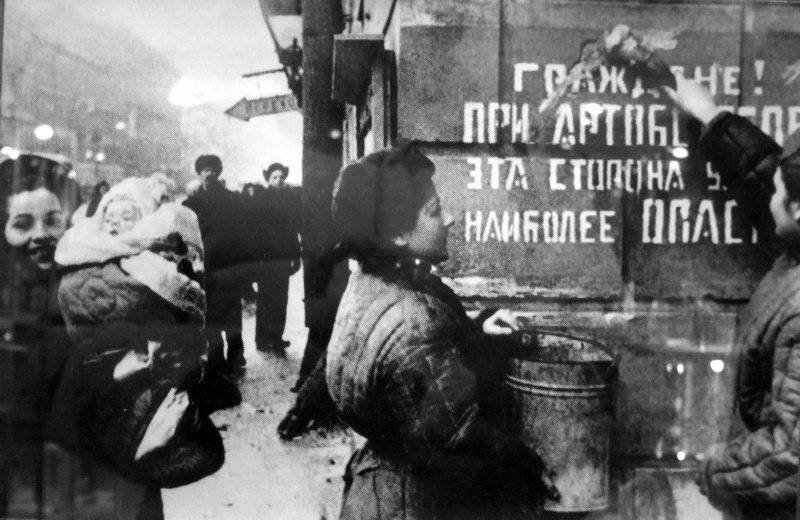
Leningradians paint over the inscription on the wall of the house, warning about the shelling, after the final liberation of the city from the enemy blockade.
Offensive plans of the Soviet command
In September 1943, the Military Councils of the Leningrad and Volkhov fronts submitted to the Headquarters of the Supreme High Command plans for a joint large-scale offensive. The Military Council of LF proposed to deliver the main blow to the 42 army from the Pulkovo region and the Primorsk operative group from the Oranienbaum springboard. The troops were supposed to unite in the area of Red Selo. Then the troops of the 67 Army were to liberate Krasnogvardeisk and continue the offensive in the general direction of Luga and Kingisepp. The VF was to deliver the main attack from the Novgorod region in the direction of Luga, where the troops of the front were to unite with the LF forces. Thus, the troops of the Leningrad and Volkhov fronts were to surround and destroy the main forces of the German 18-th army. In the future, Soviet troops were to develop an offensive against Pskov and the Island.
Intelligence reported that German troops near Leningrad would soon retreat to new defensive lines. Given the new intelligence, the Leningrad, Volkhov, and North-Western fronts were instructed to be ready, if necessary, to immediately go on the offensive in order to pursue enemy forces. Taking into account the possibility of development of events under this scenario, the plan “Neva-1” was developed. Soviet troops were ready to immediately deploy the pursuit of German troops. The plan "Neva-2" was developed taking into account that the Wehrmacht will continue to hold its position near Leningrad.
Simultaneously with the headquarters of the Leningrad and Volkhov fronts, plans for a larger operation were prepared by the Supreme Command Headquarters and the General Staff. They planned to surround and destroy the main forces of Army Group North. Taking into account the possible withdrawal of the 18 of the German army in October, 1943 decided to strike the junction of the German Army Groups North and Center in order to cut off the German troops in the north-west direction. The Baltic front was to advance on the Idritsky direction. The forces of the Kalinin Front attacked Vitebsk, and then had to develop an offensive in the direction of Polotsk, Dvinsk and Riga. The North-Western Front received the task of advancing in the direction of the Bottom - Pskov. The Volkhov Front was supposed to hit Novgorod and then Luga. Thus, the Stavka and the General Staff planned to destroy the main forces of the Army Group North, to finally release Leningrad, to liberate the Leningrad Region, Estonia and Latvia.
However, the troops of the Kalinin and Baltic fronts did not achieve decisive success. On October 20, these fronts were transformed into the 1 and 2 Baltic fronts, and the North-Western Front was disbanded. The Baltic fronts held positions in the Vitebsk and Idritsky directions. Despite some successes, these fronts could not create a favorable operational position for a subsequent strategic offensive. Therefore, it was decided to abandon the idea of a large-scale plan for encircling Army Group North. The Supreme High Command headquarters decided to deliver the main blow by the forces of the Leningrad and Volkhov fronts, since the plan for their offensive has already been developed. The headquarters decided that the defeat of the 18 Army and the final deblokade of Leningrad would irrevocably change the situation on the Baltic direction in favor of the Red Army.
At the same time, the 2 Baltic Front was to go on the offensive. The front received the task of defeating the enemy forces in the Nevel region, developing an offensive against Idritsa and north of Novosokolnikov to cut off the enemy’s main communications and pin down the main forces of the 16 army, preventing them from coming to the aid of the 18 army. In the future, the troops of the 2 of the Baltic Front were to advance in the direction of Sebezh and Opochka. In the case of successful development of the offensive of the 2 of the Baltic Front, the possibility arose of surrounding the main forces of the Army Group North and the rapid withdrawal of Soviet troops to Estonia and Latvia.
Thus, at the first stage of the offensive, the forces of the Volkhov and Leningrad fronts were to destroy the connections of the 18 Army, and the 2 Baltic Front bound the forces of the 16 Army and operational reserves of Army Group North to their actions. In the case of the success of the first stage of the offensive of all three Soviet fronts, advancing on the Narva, Pskov and Idrytsky axes, the troops of the German 16 were to be defeated. After the liberation of the Leningrad region, conditions emerged for the liberation of the Baltic republics.
German forces
The front line of the German Army Group "North" remained without significant changes for a significant part of the war. At the closest approaches to Leningrad, the 18 Army continued to be led by cavalry general Georg Lindemann. It consisted of: 3-th SS tank corps, 26-th, 28-th, 38-th, 50-th, 54-th army corps (19 divisions and 3 brigades). On the right flank of the 18 Army and the junction of Army Group North with Army Group Center were the 16 Army under the command of Colonel-General Christian Hansen. The 16 army included: 1, 2, 8, 10, 43 army corps and 6 CC corps (21 division and 1 brigade). Both armies numbered up to 500 thousand people. From the air they were covered by airplanes of the 1 air fleet under the command of General Kurt Pflugbeil (370 airplanes). Leningrad was constantly subjected to artillery shelling. In order to bombard the city, the German command formed two special artillery groups consisting of 75 heavy batteries and 65 light artillery batteries. The whole group of armies "North" numbered 741 thousand people (according to other data more than 600 thousand people), had more than 10 thousand guns of mortar 385 tanks and assault guns.
The command of Army Group North, in connection with the general deterioration of the situation on the Eastern Front, prepared a plan for a retreat from near Leningrad. The troops were to withdraw to the powerful line of defense "Panther". The line included two defense lines: 1-I was on the shores of Pskov Lake, the Great, Pskov and Cherekhi rivers, 2-I ran along the western bank of the Great River and the Narova to the Baltic Sea near Narva. The retreat was to be carried out gradually, in several stages from mid-January to spring 1944. In the depth of the defense of the 18 Army there were several intermediate defensive lines. However, the blockade of Leningrad was of great strategic importance for Berlin. It allowed to squeeze significant forces of the Red Army and the Baltic Fleet, to close the approaches to the Baltic States and its ports and naval bases, to maintain the freedom of action of the German Navy in the Baltic and to provide maritime communications with Finland and Sweden. In addition, Adolf Hitler believed that the Red Army did not have enough strength to simultaneously continue the offensive in the south and strike in the north. And the commander of the 18 th army, Lindeman assured the Fuhrer that his troops would repel the enemy's strike. Therefore, Army Group North was ordered to maintain its position in the Leningrad region at any cost.
For two and a half years the German troops strengthened very thoroughly. The Nazis created a powerful and well-equipped in engineering defense. The line of defense consisted of a system of strong nodes of resistance and strongholds, which had a fire connection and were located taking into account the peculiarities of the marshy and marshy and lake areas. A particularly powerful defense was in the area of Pulkovo Heights and north of Novgorod. Here there were not only machine-gun points, but also reinforced concrete pillboxes, anti-tank ditches and cannons. In addition, the defensive side was assisted by a woodland and marshland. Soviet troops had to overcome many rivers, streams, streams, lakes and marshes. There were few dirt roads, the railways were destroyed. Thaw made the operation even more difficult.
Soviet forces
The defeat of Army Group North and the complete liberation of the Leningrad Region were to be carried out by the troops of the Leningrad Front under the command of Army General Leonid Govorov, the Volkhov Front under the command of Army General Kirill Meretskov and 2 of the Baltic Front Army General Markian Popov. The operation also involved the forces of the Red Banner Baltic Fleet under the command of Admiral Vladimir Tributs and Long-Range Aviation under the command of Air Marshal Alexander Golovanov.
LF defended the Oranienbaum bridgehead, positions around Leningrad from the Gulf of Finland to the Neva River, as well as along the southern coast of Lake Ladoga from Moscow Dubrovka to Gontovaya Lipka. The LF consisted of the 2-I shock army, the 42-I and 67-I armies and the 13-I air army. From the air front also supported the aircraft of the Leningrad Army air defense and aviation of the Baltic Fleet. All in all, LF had 30 rifle divisions, 3 rifle and 4 tank brigades and 3 fortified areas, as well as a significant number of other connections with a total of more than 417 thousand people. LF offensive supported part of the Baltic Fleet - about 90 thousand people.
The Volkhov Front occupied defenses from Gontova Lipki to Lake Ilmen. The front consisted of units of the 59, 8 and 54 armies, 14 air army. The army consisted of 22 rifle divisions, 6 rifle and 4 tank brigades, 14 tank and self-propelled artillery regiments and battalions, 2 strengthened, as well as a large number of artillery, mortar and engineering units - only about 260 thousand soldiers and officers.
The 2 Baltic Front held positions on the line from Lake Ilmen to Lake Neshcherda. The front consisted of units of the 6 th, 10 th Guards, 1 th, 3 th shock and 22 th armies, 15 th air army. The armies of the 2 Baltic Front numbered 45 rifle divisions, 3 rifle and 4 tank brigades, 1 fortified, as well as artillery and engineering units.
Total Soviet troops before the attack numbered more than 1 million 250 thousand people (according to other data 900 thousand people), more than 20 thousand guns and mortars, more than 1500 tanks and ACS, 1386 aircraft, including 330 long-range aircraft. In addition, the offensive of the Red Army was supported by partisan units. Only in the area of the offensive of the Leningrad Front, there were 13 guerrilla brigades, whose numbers reached 35 thousand people.
Offensive
The January Thunder, Krasnoselsko-Ropshinskaya operation (14 - 30 January 1944 of the year). On the eve of the attack on the Oranienbaum bridgehead, the 2 shock army, which was led by Lieutenant-General Ivan Fedyuninsky, was redeployed. The forces of the Baltic Fleet and transport aviation to the bridgehead before the operation and already in the course of it transferred 5 rifle divisions, 13 artillery regiments, one tank brigade, 2 tank regiment and one regiment of SAU.
On January 14, the 2nd shock army with the forces of two rifle corps struck from the Oranienbaum bridgehead. On January 15, three rifle corps of Ivan Maslennikov's 42nd Army went on the offensive from the Pulkovo area. Both armies attacked in the direction of Krasnoe Selo and Ropsha. Before the start of the offensive, sappers made passes through minefields and barbed wire, and aviation and artillery struck at the defense centers and firing positions of the German troops. However, in the early days, the advance of the Soviet troops was insignificant. German troops, relying on well-prepared defenses, offered fierce resistance, and at every opportunity they made desperate counterattacks. At the same time, Soviet troops faced skillful and stubborn resistance from select German units. In particular, in the area of the Oranienbaum bridgehead, the defense was held by units of the 3rd SS Panzer Corps under the command of F. Steiner. It consisted of the 11th SS Panzer Grenadier Division "Norland", the 9th and 10th Luftwaffe Field Divisions, the 4th SS Volunteer Tank Grenadier Brigade "Netherlands" and one regiment of the SS Police Division. The 50th Army Corps held back the advance of the 42nd Army. Due to the large number of anti-tank ditches and minefields, as well as the effective fire of German artillery, the mechanized units of Maslennikov's army suffered heavy losses and could not properly support the offensive of the riflemen.
In three days of stubborn fighting, the two Soviet armies advanced no more than 10 km. The troops of the 2 shock and 42 armies did not have enough experience to break through the strong defenses of the enemy. Nevertheless, the troops of the 2 th shock army by the end of the third day were able to penetrate the main defensive line of the enemy on the front to 23 kilometers. The commander Fedyuninsky formed a mobile group (152-I tank brigade and several rifle and artillery units), which introduced a breakthrough. The mobile team received the task to capture and keep Ropsha. The commander of the 42 th army also launched the 17 of January into battle reserves and a mobile group (1-I Leningradskaya Red Banner, 220-I tank brigades and two regiments of the SAU). The mobile group received the task of freeing Krasnoye Selo, Dudergof and Crow Mountain.
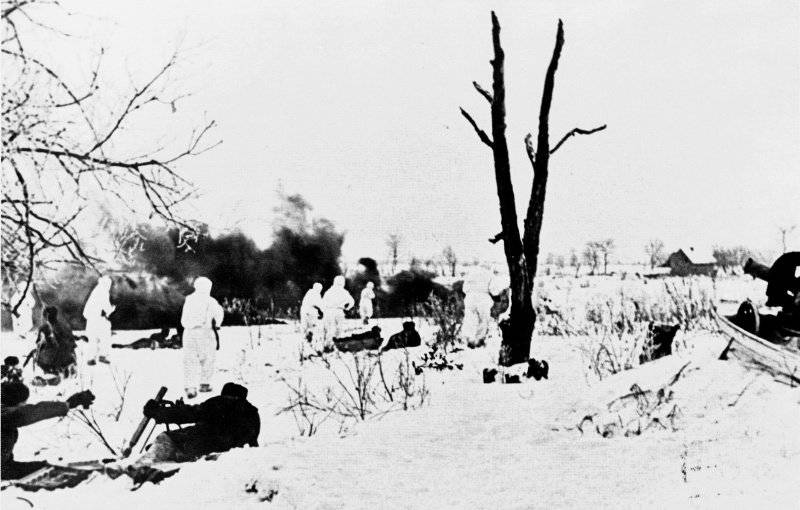
Soviet fighters are attacking the enemy in the area of Ropsha. The photo was taken during the operation on the final lifting of the blockade of Leningrad (Operation “The January Thunder”).
The Germans began to run out of steam. They used all the tactical reserves, and the operational reserve was the 61 Infantry Division. German troops in the areas of Red Selo, Ropsha and Strelna were threatened with encirclement. Commander of Army Group North, Georg von Kühler decided to withdraw part of the 26 Army Corps from the Mginsky ledge to help the defense in the Red Village area. But the transfer of these troops could not change the situation.
19 January, the troops of the two Soviet armies liberated Krasnoye Selo and Ropsha. On the same day, the troops of the two fronts united. The German command, taking advantage of the fact that there was no solid front line yet, diverted most of the troops from the encirclement area. January 20 was destroyed remnants of the Peterhof-Strelnenskaya enemy group. The Germans, retreating, threw heavy weapons and siege equipment, which accumulated over the years at Leningrad. Soviet troops captured 265 guns, including heavy 85. The Germans were rejected from the second Soviet capital on 25 km.
The defeat of the Peterhof-Strelna group and the successes of the Volkhov front, which also went on the offensive on January 14, created favorable conditions for the continuation of the LF offensive. The Maslennikov army received an order to strike in the direction of Krasnogvardeisk, Pushkin and Tosno, in order to go to the rear of the forces of Army Group North, which held positions in the area of Ulyanovka, Mgi and Tosno. Subsequently, the 42 Army should break up the 26 and 28 German Army Corps and, in cooperation with the forces of the 67 Army of Sviridov and the right wing of the VF, establish control over the October Railway and completely remove the ring surrounding Leningrad. The forces of the Fedyuninsky army received the task of circumventing Krasnogvardeisk from the south-west direction, facilitating the offensive of the 42 army.
On January 21, units of the 67 Army of the LF and the 8 Army of the VF, having discovered the withdrawal of the enemy’s MGNA group, launched an offensive. On the same day, Soviet troops liberated MGu. The Germans fought off the Kirov railway. However, they could not develop the offensive. The Nazis took up positions on the intermediate defensive line of the Autostrada along the October Railway and put up stubborn resistance.
The departure of the Germans from Mga forced the LF command to correct plans. Now the main task of the 2 shock and 42 armies was the attack on Krasnogvardeisk, and then on Kingisepp and Narva. The 67 Army was to occupy the October Railway and support the attack on Krasnogvardeisk.
For several days there were stubborn battles on the line of the October Railway, for Krasnogvardeysk, Pushkin and Slutsk. The Germans tried to keep at all costs Krasnogvardeysk. The commander of Army Group North turned several connections into the area. Hitler refused to allow the withdrawal of troops from the line of the October Railway, from Pushkin and Slutsk.
On January 24, Pushkin and Slutsk were released. January 25 began a decisive assault on Krasnogvardeisk. Fierce battles went on for almost a day. January 26, Krasnogvardeisk cleared of the Nazis. The solid defense front of the 18th German army was broken, the German divisions retreated. The 2nd shock army reached the Luga River by January 30. On the night of February 1, Kingisepp was stormed. The Germans, unable to maintain a position on the Meadow, retreated to the frontier on the Narva River. Units of the 42nd Army, developing the offensive in a southwestern direction, also reached the Luga and occupied a bridgehead in the Greater Sabsk region. The troops of the 67th army under the command of Sviridov, overcoming strong enemy resistance, liberated Vyritskaya on January 27, and recaptured Siversky by January 30.
Thus, in part of the Leningrad and Volkhov fronts, in cooperation with the Baltic Fleet, they broke through the powerful defenses of the enemy and inflicted a heavy defeat on the 18 of the German army. The Soviet soldiers finally released Leningrad, advanced 70-100 km. 27 January in Leningrad and Moscow was made a solemn salute in honor of the final elimination of the blockade of the northern capital of the USSR. Three hundred and twenty-four guns struck in honor of the great victory. The people of Leningrad rejoiced: the terrible blockade that claimed thousands of lives is gone.
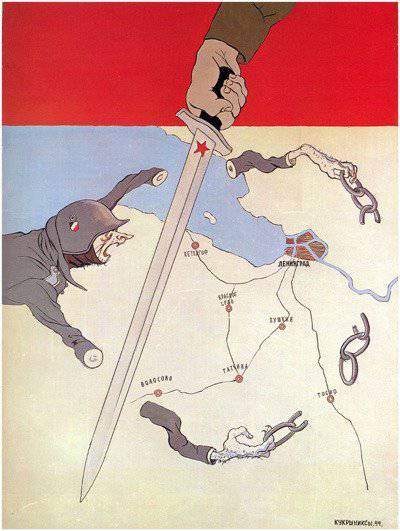
Kukryniksy. Hands are short.
To be continued ...
- Alexander Samsonov
- The first "Stalinist strike": the complete elimination of the blockade of Leningrad
The first "Stalinist strike." Part of 2. The liberation of Veliky Novgorod from the German invaders
The second Stalinist blow. Liberation of Right-Bank Ukraine
The second Stalinist blow. Part of 2. Destruction of the enemy's Korsun-Shevchenko grouping
The second Stalinist blow. Part of 3. The defeat of the Nikopol-Krivoy Rog adversary group
The second Stalinist blow. Part of 4. Proskurov-Chernivtsi offensive
The second Stalinist blow. Part of 5. Uman-Botosha operation
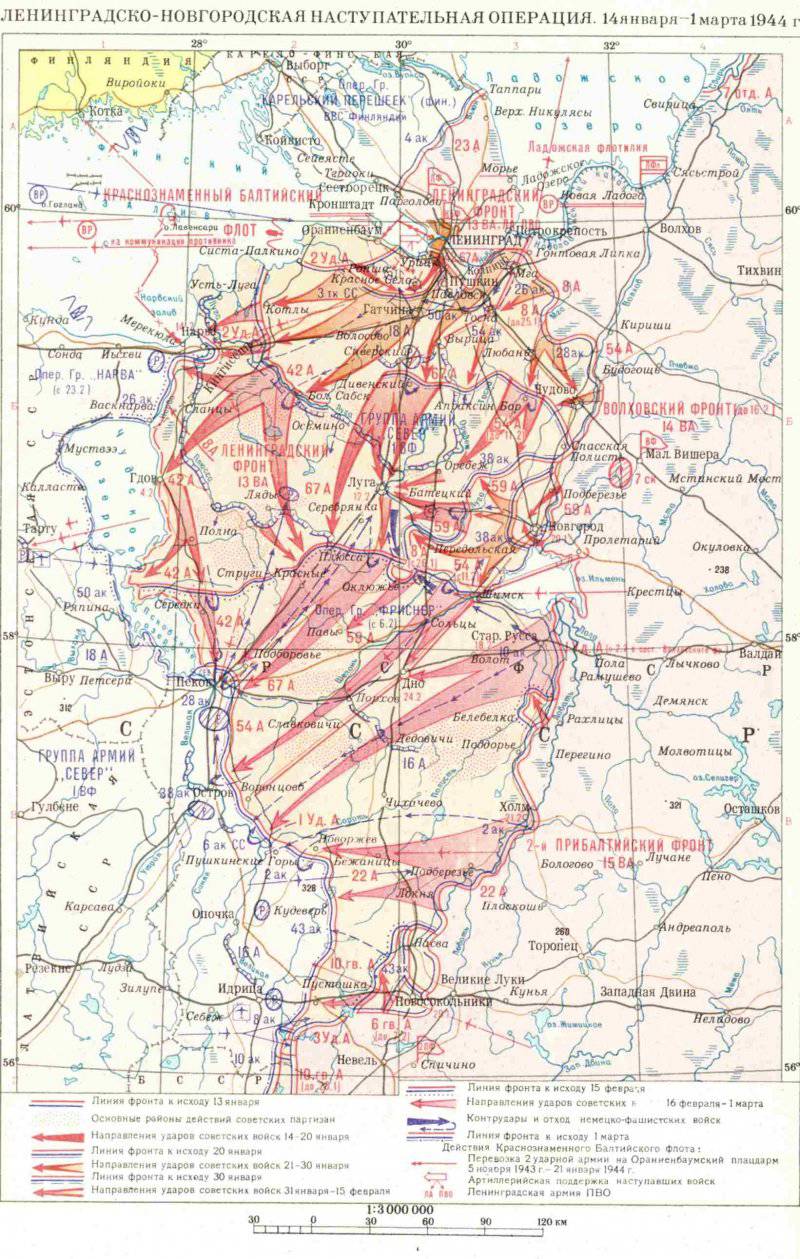
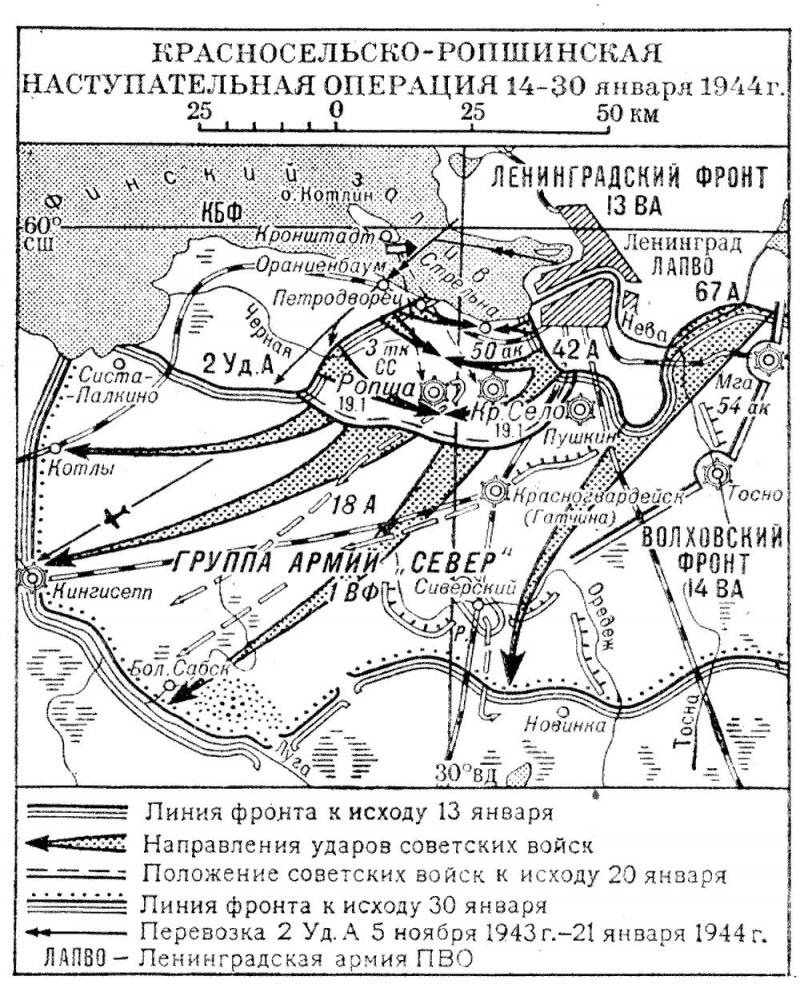
Information